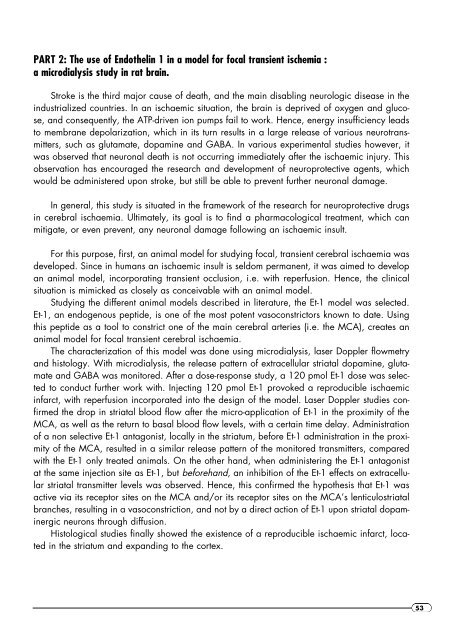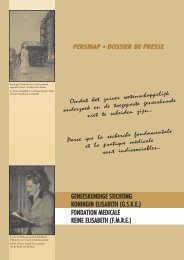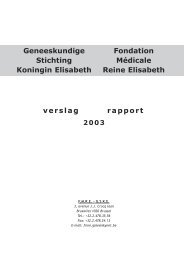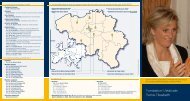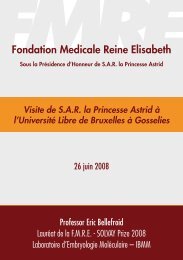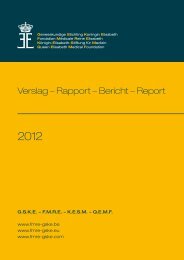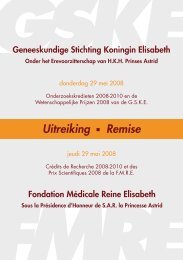Geneeskundige Stichting Koningin Elisabeth ... - GSKE - FMRE
Geneeskundige Stichting Koningin Elisabeth ... - GSKE - FMRE
Geneeskundige Stichting Koningin Elisabeth ... - GSKE - FMRE
Create successful ePaper yourself
Turn your PDF publications into a flip-book with our unique Google optimized e-Paper software.
PART 2: The use of Endothelin 1 in a model for focal transient ischemia :<br />
a microdialysis study in rat brain.<br />
Stroke is the third major cause of death, and the main disabling neurologic disease in the<br />
industrialized countries. In an ischaemic situation, the brain is deprived of oxygen and glucose,<br />
and consequently, the ATP-driven ion pumps fail to work. Hence, energy insufficiency leads<br />
to membrane depolarization, which in its turn results in a large release of various neurotransmitters,<br />
such as glutamate, dopamine and GABA. In various experimental studies however, it<br />
was observed that neuronal death is not occurring immediately after the ischaemic injury. This<br />
observation has encouraged the research and development of neuroprotective agents, which<br />
would be administered upon stroke, but still be able to prevent further neuronal damage.<br />
In general, this study is situated in the framework of the research for neuroprotective drugs<br />
in cerebral ischaemia. Ultimately, its goal is to find a pharmacological treatment, which can<br />
mitigate, or even prevent, any neuronal damage following an ischaemic insult.<br />
For this purpose, first, an animal model for studying focal, transient cerebral ischaemia was<br />
developed. Since in humans an ischaemic insult is seldom permanent, it was aimed to develop<br />
an animal model, incorporating transient occlusion, i.e. with reperfusion. Hence, the clinical<br />
situation is mimicked as closely as conceivable with an animal model.<br />
Studying the different animal models described in literature, the Et-1 model was selected.<br />
Et-1, an endogenous peptide, is one of the most potent vasoconstrictors known to date. Using<br />
this peptide as a tool to constrict one of the main cerebral arteries (i.e. the MCA), creates an<br />
animal model for focal transient cerebral ischaemia.<br />
The characterization of this model was done using microdialysis, laser Doppler flowmetry<br />
and histology. With microdialysis, the release pattern of extracellular striatal dopamine, glutamate<br />
and GABA was monitored. After a dose-response study, a 120 pmol Et-1 dose was selected<br />
to conduct further work with. Injecting 120 pmol Et-1 provoked a reproducible ischaemic<br />
infarct, with reperfusion incorporated into the design of the model. Laser Doppler studies confirmed<br />
the drop in striatal blood flow after the micro-application of Et-1 in the proximity of the<br />
MCA, as well as the return to basal blood flow levels, with a certain time delay. Administration<br />
of a non selective Et-1 antagonist, locally in the striatum, before Et-1 administration in the proximity<br />
of the MCA, resulted in a similar release pattern of the monitored transmitters, compared<br />
with the Et-1 only treated animals. On the other hand, when administering the Et-1 antagonist<br />
at the same injection site as Et-1, but beforehand, an inhibition of the Et-1 effects on extracellular<br />
striatal transmitter levels was observed. Hence, this confirmed the hypothesis that Et-1 was<br />
active via its receptor sites on the MCA and/or its receptor sites on the MCA’s lenticulostriatal<br />
branches, resulting in a vasoconstriction, and not by a direct action of Et-1 upon striatal dopaminergic<br />
neurons through diffusion.<br />
Histological studies finally showed the existence of a reproducible ischaemic infarct, located<br />
in the striatum and expanding to the cortex.<br />
53


